Creating great content is only half the battle; getting it in front of the right audience at the right time is the other. In a saturated digital landscape, relying on manual posting and promotion is inefficient and unsustainable. Your team invests significant resources into producing valuable articles, videos, and reports. Letting that content underperform due to a weak distribution process means leaving engagement, leads, and revenue on the table. This is the core problem that content distribution software is designed to solve.
These platforms act as powerful amplifiers, automating the process of sharing your work across multiple channels, from social media to email newsletters and partner networks. They help you schedule, manage, and measure the impact of your efforts, ensuring your message reaches its intended audience without requiring countless hours of manual work. To truly amplify your content and achieve broader reach, it’s essential to integrate your distribution tools with overall effective content marketing strategies. This synergy ensures your amplified content aligns perfectly with your business goals.
But with dozens of tools available, each with unique features and pricing models, finding the right fit can be overwhelming. This guide cuts through the noise. We’ve compiled a comprehensive list of the best content distribution software, analyzing each option for its specific strengths, ideal use cases, and potential drawbacks. For every platform, you will find:
- A detailed breakdown of key features and capabilities.
- Honest pros and cons based on practical application.
- Clear pricing information.
- Direct links and screenshots to see the software in action.
Our goal is simple: to provide a clear, practical resource that helps you move from consideration to decision. Let’s find the right software to maximize your content’s ROI and streamline your workflow.
1. EvergreenFeed
Best for Automating Evergreen Social Media Content
EvergreenFeed establishes itself as a premier choice in the content distribution software landscape by mastering a specific, high-impact niche: the automated recycling of evergreen social content. It’s designed for marketers, bloggers, and businesses who want to maximize the lifespan and reach of their best-performing content without dedicating hours to manual scheduling. The platform’s core strength lies in its intelligent automation, which ensures your social media feeds remain consistently active and engaging.
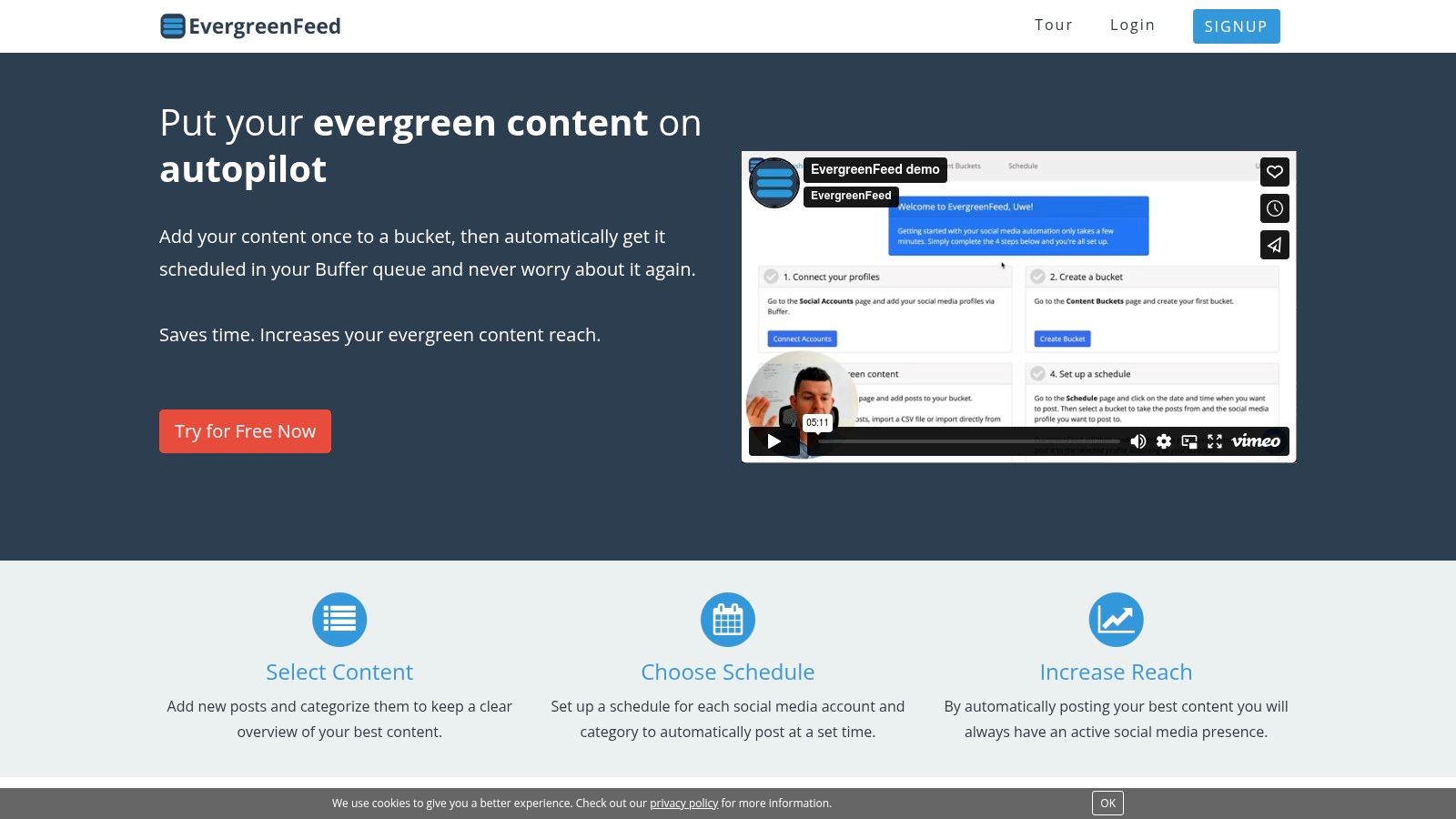
Unlike general-purpose schedulers, EvergreenFeed operates on a “set it and forget it” principle for your most valuable posts. By integrating directly with Buffer, it allows you to create categorized “buckets” of content, such as blog posts, user-generated content, or promotional materials. You then define a posting schedule for each bucket, and the platform takes over, randomly selecting and publishing content to your designated social profiles. This smart randomization prevents your feed from looking repetitive while ensuring continuous visibility.
Key Features & Analysis
- Automated Content Buckets: This is EvergreenFeed’s standout feature. It moves beyond simple queueing by allowing deep categorization. For example, a marketing agency can create separate buckets for client case studies, industry news, and team culture posts, then set different posting frequencies for each to maintain a balanced content mix across all managed accounts.
- Buffer Integration: The reliance on Buffer is both a strength and a limitation. For the thousands of teams already embedded in the Buffer ecosystem, integration is seamless and takes minutes. This focus allows for a more stable and deeply integrated experience than tools that support dozens of APIs.
- Tailored Multi-Account Scheduling: Users can manage numerous social accounts and customize schedules with precision. You can decide that blog posts are shared on Twitter three times a day but only once on LinkedIn, giving you granular control over your distribution strategy for each platform.
- Performance Analytics: The platform provides insights into how your evergreen content is performing, helping you refine your content buckets by removing underperforming posts and doubling down on what resonates with your audience.
Practical Use & Implementation
Getting started is straightforward. You can sign up for a free account without a credit card, link your Buffer account, and begin creating your content buckets immediately.
Pro Tip: Create a “Top Performers” bucket for your posts with the highest historical engagement. Schedule this bucket to post during peak traffic hours to maximize its impact and drive consistent traffic back to your website.
The platform is ideal for social media managers aiming to save significant time, with users reporting savings of over seven hours per week. It’s a powerful tool for maintaining an active presence, growing follower counts, and ensuring your best content doesn’t get lost after a single post.
| Pros | Cons |
|---|---|
| Drastically reduces time spent on manual social media scheduling | Exclusively integrates with Buffer, limiting its use for other schedulers |
| Organizes content effectively through custom buckets | Advanced features and higher post limits require a paid subscription |
| Enables granular, platform-specific scheduling strategies | |
| Proven to boost engagement and follower growth with consistent posting |
Website: https://www.evergreenfeed.com
2. HubSpot Marketing Hub
HubSpot Marketing Hub is less a single tool and more of an all-in-one ecosystem for inbound marketing. While many platforms focus on one aspect of distribution, HubSpot integrates content creation, optimization, and multi-channel promotion into a single, unified dashboard. This makes it an exceptional piece of content distribution software for teams looking to centralize their efforts and leverage customer data for more effective campaigns.

What truly sets it apart is its powerful, integrated CRM. Every interaction, from a blog view to an email open, is tracked against a contact record. This allows for hyper-personalized content distribution, such as sending targeted follow-up emails based on which pillar page a user read or promoting a specific social post to leads in a certain lifecycle stage. It effectively bridges the gap between content and sales.
Key Features and Pricing
HubSpot’s functionality is extensive, but its core distribution strengths lie in its ability to connect different marketing activities. This integration is key to developing sophisticated, data-driven content distribution strategies.
- Social Media Management: Schedule and publish content directly to LinkedIn, Facebook, Instagram, and X (formerly Twitter).
- Email Marketing: Build and automate email campaigns, from simple newsletters to complex drip sequences.
- SEO & Content Strategy: Get real-time SEO recommendations as you write blog posts and build topic clusters.
- Analytics & Reporting: Create custom dashboards to track content performance across every channel.
Pricing: HubSpot offers a free tier with basic tools. Paid plans start with the Starter plan (from $18/month), Professional (from $800/month), and Enterprise (from $3,600/month), with costs scaling based on the number of marketing contacts.
| Pros | Cons |
|---|---|
| All-in-one platform simplifies marketing stack | High price point for advanced tiers |
| User-friendly interface and extensive support | Can have a steep learning curve for complex features |
| Powerful automation tied directly to CRM data | Some tools are less robust than standalone options |
Ideal Use Case: HubSpot is best for B2B companies and established small to enterprise-level businesses committed to an inbound marketing methodology. It excels for teams that need to align marketing and sales efforts around a single source of customer data.
3. Hootsuite
While many tools offer social media scheduling, Hootsuite has solidified its position as a cornerstone platform for comprehensive social media management and distribution. It allows teams to manage all their social channels, schedule unlimited posts, and monitor conversations from a single, unified dashboard. For brands where social media is a primary channel, Hootsuite is an indispensable piece of content distribution software that centralizes control and streamlines workflows.
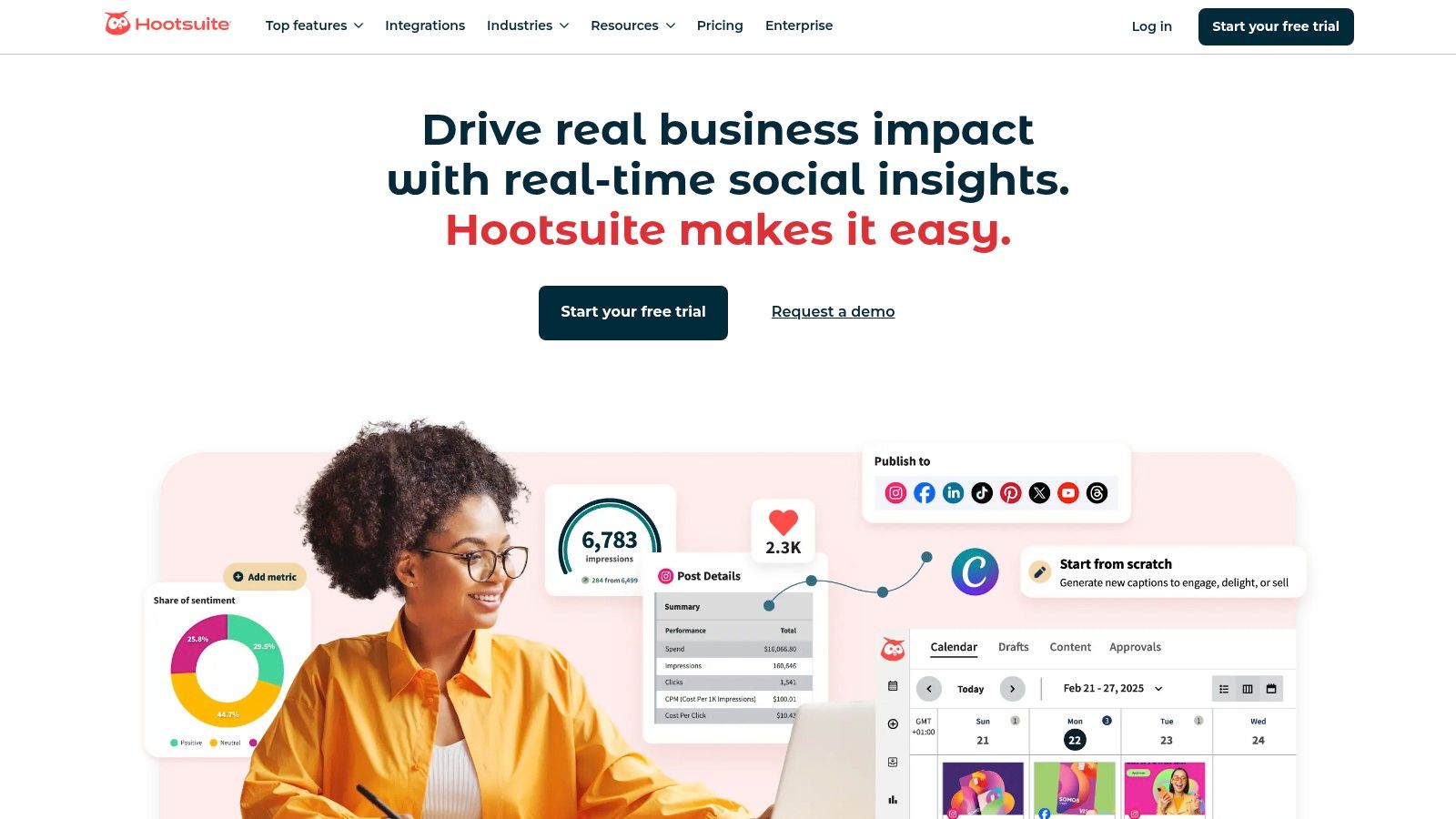
What makes Hootsuite stand out is its powerful “Streams” feature. This allows users to create custom feeds to monitor specific hashtags, keywords, mentions, or lists across different platforms. This goes beyond simple publishing, turning the platform into a tool for social listening, competitor analysis, and identifying user-generated content for redistribution. It transforms social media from a broadcast medium into a two-way communication and intelligence-gathering channel.
Key Features and Pricing
Hootsuite’s strength lies in its ability to bring all social activity under one roof, providing a command center for teams. This holistic view is crucial for executing a cohesive social distribution strategy.
- Bulk Scheduling: Upload and schedule hundreds of social media posts at once across various networks.
- Social Listening & Monitoring: Track brand mentions, relevant keywords, and industry trends in real-time.
- Unified Social Inbox: Manage all incoming messages and comments from different social channels in one place.
- Analytics & Reporting: Measure performance with customizable reports that track metrics like reach, engagement, and link clicks.
Pricing: Hootsuite offers a Professional plan (from $99/month), a Team plan (from $249/month), and custom-priced Business and Enterprise tiers for larger organizations. A limited 30-day free trial is available for the Professional and Team plans.
| Pros | Cons |
|---|---|
| Comprehensive social media management in one hub | The interface can feel busy and complex for beginners |
| Supports a very wide range of social networks | Higher-tier plans are expensive for smaller teams |
| Robust analytics and reporting features | Add-ons for advanced features can increase costs |
Ideal Use Case: Hootsuite is best suited for social media managers, marketing agencies, and businesses of all sizes that heavily rely on social media for content distribution. It is particularly effective for teams that need to manage multiple accounts, collaborate on social campaigns, and gain deep insights from social analytics.
4. Buffer
Buffer is a streamlined and intuitive social media management tool designed to simplify the process of sharing content across multiple networks. Its core strength lies in its simplicity and focus on scheduling, making it an excellent piece of content distribution software for individuals and small teams who need an efficient, no-frills solution. Rather than overwhelming users with a vast array of features, Buffer excels at doing a few things exceptionally well: planning, scheduling, and publishing social media content.
What makes Buffer a standout choice, especially for those new to social media management, is its clean user interface and gentle learning curve. The platform’s scheduling queue and “optimal timing” suggestions take the guesswork out of posting, allowing marketers to load up their content calendar and trust that it will be distributed effectively. This focus on straightforward execution makes it a reliable workhorse for maintaining a consistent social presence without a significant time investment.
Key Features and Pricing
Buffer’s functionality is centered on making social media distribution as effortless as possible. Its features are geared towards efficiency, from content curation to performance analysis, providing a solid foundation for any social media strategy. For those looking to dive deeper into automation, this guide to social media automation provides additional context.
- Publishing & Scheduling Tools: A drag-and-drop calendar to plan and schedule posts for Instagram, Facebook, X (formerly Twitter), LinkedIn, Pinterest, and more.
- Engagement Tools: A centralized inbox to view and respond to comments and mentions across platforms.
- Analytics & Reporting: Track key metrics like reach, engagement, and follower growth with easy-to-understand reports.
- Start Page: Create a simple, beautiful landing page to house your most important links.
Pricing: Buffer offers a generous free plan that allows for up to 3 channels. Paid plans include Essentials (starting at $6/month per channel), Team (starting at $12/month per channel), and Agency (starting at $120/month for 10 channels).
| Pros | Cons |
|---|---|
| Extremely intuitive and user-friendly interface | Analytics are less advanced than some competitors |
| Affordable pricing, especially for small teams | Some features like engagement are in separate products |
| Excellent customer support and reliability | Lacks the all-in-one scope of larger platforms |
Ideal Use Case: Buffer is perfect for bloggers, solopreneurs, and small businesses that need a simple and effective tool to manage their social media presence. It is also a great starting point for teams looking to bring structure to their social content distribution without committing to a complex, high-cost platform.
5. Mailchimp
While primarily known as an email marketing powerhouse, Mailchimp has evolved into a comprehensive marketing platform that serves as powerful content distribution software, especially for small businesses and creators. It excels at delivering content directly to a captive audience through highly engaging email campaigns. Its strength lies in making sophisticated email marketing accessible, allowing users to easily segment audiences and automate communication.
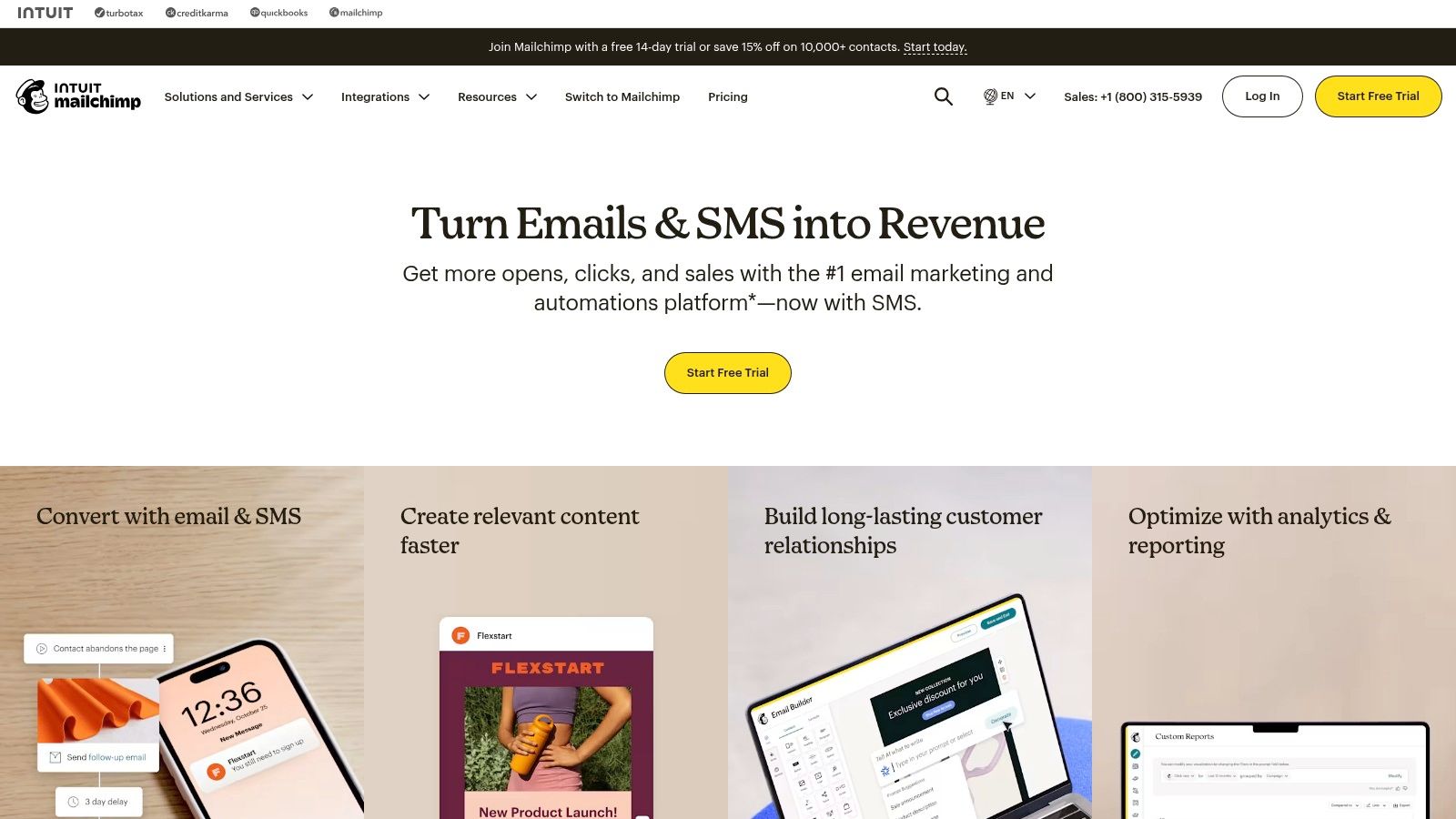
What makes Mailchimp a standout for content distribution is its user-friendly approach to audience management and automation. You can create customer journeys that automatically send new blog posts to interested subscribers, promote a new lead magnet to a specific segment, or re-engage inactive users with your best-performing content. This direct line of communication is invaluable for driving repeat traffic and nurturing leads without a steep learning curve.
Key Features and Pricing
Mailchimp’s core value is transforming your content into direct-to-inbox conversations. The platform provides all the tools needed to build, send, and analyze the performance of these crucial touchpoints.
- Email Campaign Creation: Design professional emails with a drag-and-drop editor and customizable templates.
- Audience Segmentation: Group contacts based on behavior, interests, and engagement for targeted messaging.
- Marketing Automation: Set up automated workflows (customer journeys) to send content at the right time.
- Detailed Analytics & Reporting: Track open rates, click-through rates, and audience growth to refine your strategy.
Pricing: Mailchimp offers a generous Free plan for up to 500 contacts. Paid plans are Essentials (starting at $13/month), Standard (starting at $20/month), and Premium (starting at $350/month), with costs increasing based on the number of contacts.
| Pros | Cons |
|---|---|
| Comprehensive free plan for beginners | Pricing can escalate quickly with larger lists |
| Extremely user-friendly design and templates | Advanced automation is limited to higher-tier plans |
| Extensive integration options with other tools | Less robust for multi-channel (non-email) distribution |
Ideal Use Case: Mailchimp is perfect for bloggers, small businesses, and e-commerce stores that use email as their primary channel for content distribution. Its simplicity and powerful free tier make it the ideal starting point for anyone looking to build and engage a loyal audience directly.
6. Bynder
Bynder shifts the focus of content distribution from the final promotional step to the foundational level: asset management. It is a premier Digital Asset Management (DAM) platform that empowers organizations to store, organize, and control their entire library of digital content. By centralizing everything from images and videos to brand guidelines and logos, Bynder ensures that every piece of content distributed is consistent, on-brand, and approved, making it a crucial piece of content distribution software for maintaining brand integrity at scale.

What makes Bynder so effective is its role as a “single source of truth” for creative assets. Instead of marketers searching through disparate folders or using outdated logos, the platform provides a controlled, searchable environment. Its powerful integrations allow teams to pull approved assets directly into their favorite design tools, CMS, or social media schedulers, drastically reducing workflow friction and ensuring only the correct versions are used in campaigns across any channel.
Key Features and Pricing
Bynder’s strength lies in its robust organizational and governance capabilities, which streamline the entire content lifecycle from creation to distribution. This organized approach prevents costly errors and accelerates campaign deployment.
- Centralized Digital Asset Management: A secure, cloud-based hub for all creative files with powerful metadata and search functions.
- Brand Guidelines & Templates: Enforce brand consistency with dynamic templates and accessible brand portals.
- Creative Workflow & Collaboration: Tools for version control, annotations, and approval processes to streamline content creation.
- Extensive Integrations: Connects seamlessly with Adobe Creative Cloud, various CMS platforms, social media tools, and more.
Pricing: Bynder does not publicly list its pricing. Costs are customized based on the number of users, storage requirements, and specific modules needed. You must contact their sales team for a personalized quote.
| Pros | Cons |
|---|---|
| Enforces brand consistency across all channels | Pricing is opaque and requires direct contact |
| Streamlines content creation and approval | Can have a steep learning curve for new users |
| Highly scalable for small teams to enterprises | May be overly complex for very small businesses |
Ideal Use Case: Bynder is best for mid-sized to large enterprises, especially those with distributed marketing teams or complex branding requirements. It is invaluable for organizations in regulated industries or global companies that need to maintain strict control over their brand assets across numerous campaigns and regions.
7. SocialPilot
SocialPilot is a streamlined and highly efficient social media scheduling tool that excels at the core function of getting content out to multiple networks. While it may not have the all-in-one ecosystem of a marketing hub, its strength lies in its simplicity and agency-focused features. For teams and individuals whose primary distribution channel is social media, SocialPilot serves as a powerful piece of content distribution software by making complex scheduling and multi-account management incredibly straightforward.

What makes SocialPilot a standout choice, especially for agencies or freelancers, is its exceptional value and client management capabilities. The platform allows you to connect dozens of social media accounts without the per-account cost escalation seen in many competitors. Its bulk scheduling feature, which lets you upload and schedule up to 500 posts at once via a CSV file, is a massive time-saver for high-volume content calendars.
Key Features and Pricing
SocialPilot is built for efficiency, focusing on features that directly impact social media workflow and productivity. Its content curation tool suggests relevant articles, helping to fill gaps in your content schedule.
- Bulk Scheduling: Schedule hundreds of posts across various platforms with a single CSV file upload.
- Client Management: Onboard clients and manage their accounts securely without needing their credentials.
- Content Curation & Discovery: Find and share relevant, trending content from across the web.
- Analytics & Reporting: Generate and share white-labeled PDF reports to showcase performance to clients or stakeholders.
Pricing: SocialPilot is known for its affordability. Plans start with the Professional tier (from $25.50/month), followed by Small Team (from $42.50/month), Agency (from $85/month), and Agency+ (from $170/month), all billed annually.
| Pros | Cons |
|---|---|
| Very affordable, especially for agencies | Lacks some advanced features like deep social listening |
| Clean, user-friendly interface is easy to learn | Some integrations can feel less seamless than on other tools |
| Excellent bulk scheduling and calendar views | Analytics are solid but less customizable than top-tier rivals |
Ideal Use Case: SocialPilot is perfect for marketing agencies, social media managers, and small to medium-sized businesses that need to manage a high volume of social media accounts affordably. Its no-nonsense approach to scheduling and reporting makes it a workhorse for executing social-first distribution strategies.
8. Paperflite
Paperflite positions itself as a sales enablement platform, but its core strength lies in its sophisticated content management and distribution capabilities. It’s designed to bridge the gap between marketing-created assets and the sales team’s need to share them effectively. This makes it a powerful piece of content distribution software for organizations focused on equipping their sales force with the right content at the right time.

What makes Paperflite unique is its focus on creating personalized content experiences for individual prospects. Sales reps can curate collections of assets (case studies, videos, spec sheets) into a branded microsite, or “storyboard,” for each client. The platform then provides deep analytics on how that specific prospect engages with the content, giving sales teams invaluable insights into what resonates most.
Key Features and Pricing
Paperflite excels at making content discoverable for internal teams and trackable when shared externally. This dual focus ensures that high-value assets don’t get lost in a sea of shared drives and that their impact can be measured.
- Centralized Content Repository: A single source of truth for all marketing and sales collateral, with smart search and tagging.
- Personalized Content Experiences: Create and share custom content collections for specific clients or sales conversations.
- Real-time Engagement Analytics: Track when a prospect opens, views, or shares content, down to the time spent on each page.
- CRM & Marketing Integrations: Connects with tools like Salesforce, HubSpot, and Microsoft Dynamics to sync content activity with customer records.
Pricing: Paperflite offers custom pricing based on the number of users and required features. You typically need to contact their sales team for a personalized quote.
| Pros | Cons |
|---|---|
| Enhances content visibility and engagement | Pricing can be high for small businesses |
| User-friendly interface with strong support | Some advanced features may require additional training |
| Excellent for aligning marketing and sales teams | Primarily focused on sales use cases |
Ideal Use Case: Paperflite is best for B2B organizations with established sales and marketing teams that need to improve content ROI and sales effectiveness. It’s particularly valuable for companies with complex sales cycles where personalized, high-impact content can significantly influence a deal’s outcome.
9. Joomag
Joomag is a specialized content experience platform designed for creating, distributing, and tracking interactive digital publications like magazines, catalogs, and brochures. It moves beyond simple file sharing by allowing users to embed rich media such as videos, audio, and plugins directly into their documents. This transforms static PDFs into engaging, web-based assets, making it a unique piece of content distribution software for brands focused on delivering a premium reading experience.
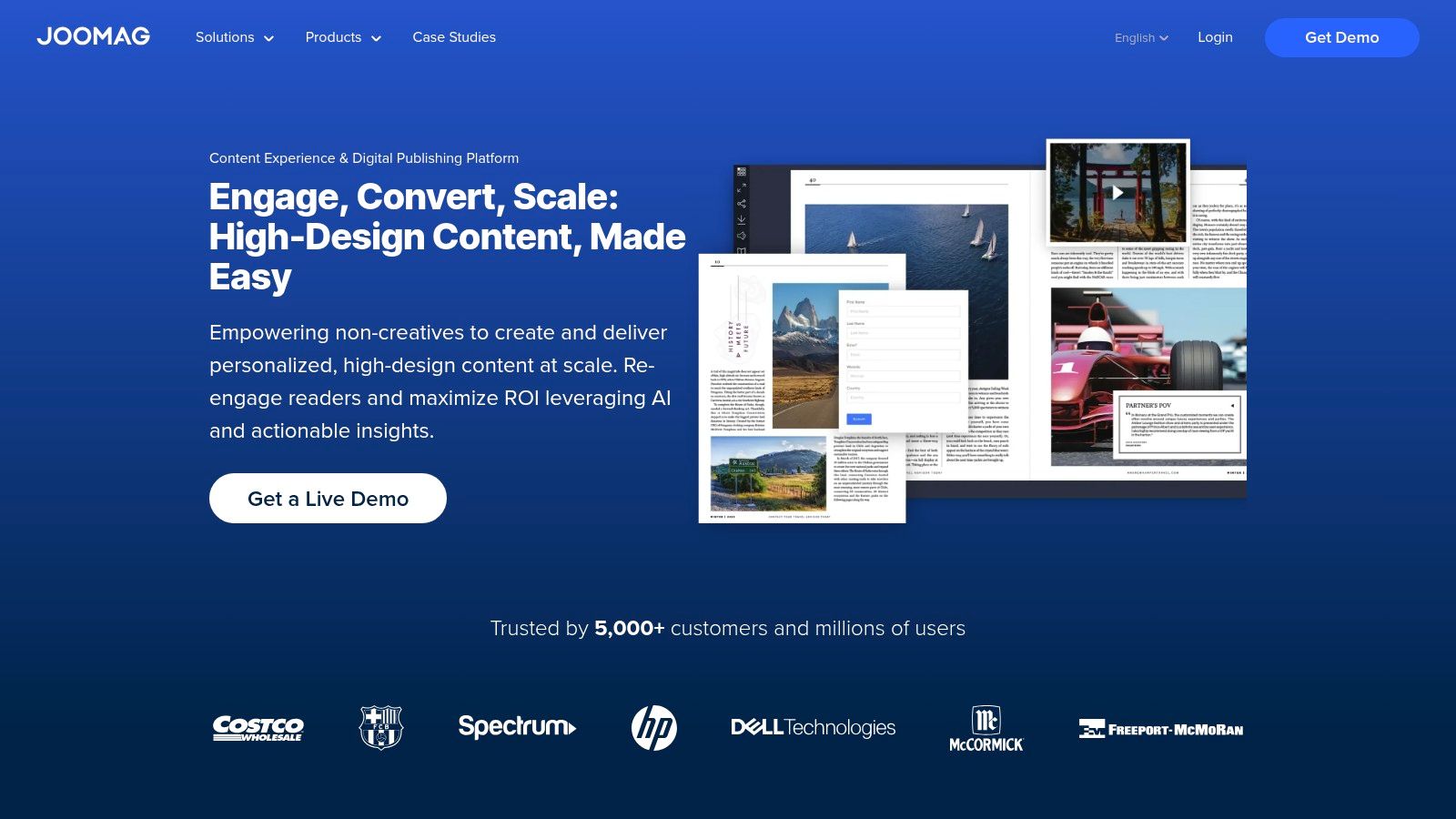
What sets Joomag apart is its focus on the entire lifecycle of a digital publication. You can design content from scratch with its user-friendly drag-and-drop editor or upload an existing PDF to enhance it. Distribution is handled through multiple channels, including direct links, email campaigns, website embedding, and a branded app. The platform closes the loop with in-depth analytics that track not just views, but reader engagement on a page-by-page level.
Key Features and Pricing
Joomag’s strength lies in its ability to centralize the creation and analysis of high-value content assets. This makes it ideal for companies that rely on detailed publications to educate and convert their audience.
- Interactive Editor: Add videos, photo galleries, audio files, and interactive plugins to your documents.
- Multi-channel Distribution: Share content via a branded viewer, email, social media, and custom mobile apps.
- Lead Generation Tools: Gate content with customizable lead forms integrated directly within the publication.
- Detailed Analytics: Monitor reader engagement, time spent per page, link clicks, and other key performance metrics.
Pricing: Joomag offers four main tiers. The Start plan begins at $39/month, Grow at $99/month, and Scale at $149/month. An Enterprise plan is also available with custom pricing for advanced needs like a branded mobile app and API access.
| Pros | Cons |
|---|---|
| Creates highly interactive and engaging content | Pricing can be high for small businesses |
| User-friendly drag-and-drop design tools | Some advanced features may require additional training |
| Comprehensive analytics for reader behavior | Focus is primarily on publication-style content |
Ideal Use Case: Joomag is best for marketing and sales teams in B2B or B2C industries that produce long-form content like digital magazines, e-books, product catalogs, or corporate reports. It excels for organizations wanting to deliver a polished, interactive reading experience and capture detailed engagement data.
10. Gain
Gain is a highly focused social media management platform designed specifically for teams that require a robust client or stakeholder approval process. While many tools offer scheduling, Gain’s superpower is streamlining the content review cycle, making it an essential piece of content distribution software for agencies, freelancers, and corporate marketing teams managing multiple brands. It centralizes content creation, feedback, and publishing into a clean, collaborative environment.
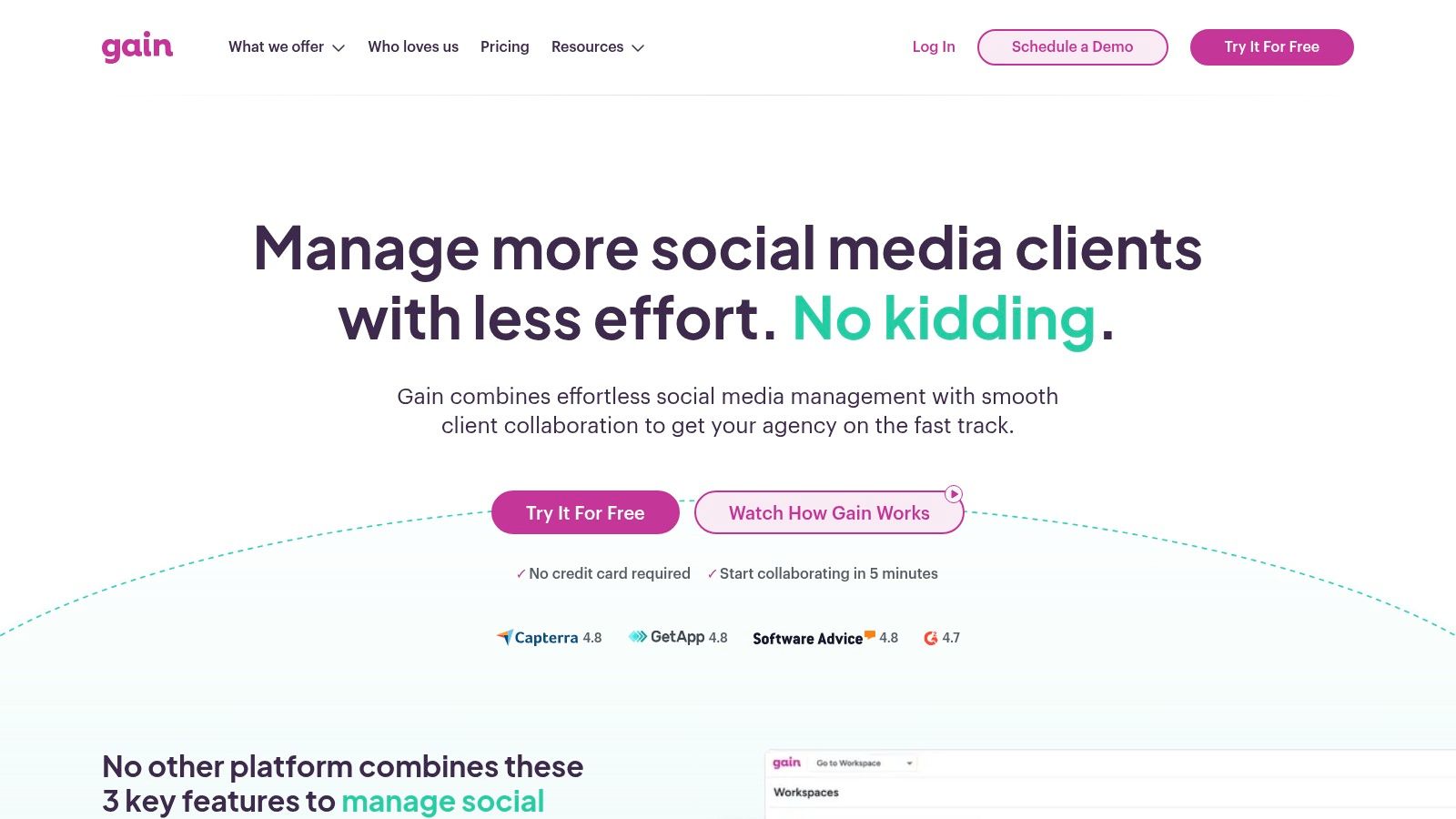
What distinguishes Gain is its laser focus on the approval workflow. Instead of messy email chains or spreadsheet trackers, clients and stakeholders can be invited directly into the platform to view, comment on, and approve content before it goes live. This significantly reduces friction and administrative overhead, allowing teams to publish content faster and with full confidence. The system is designed to be intuitive for non-marketers, which is a key advantage for client-facing work.
Key Features and Pricing
Gain’s features are built around the core need for organized content calendars and seamless approvals. This focus is key for those looking to create an effective marketing calendar with clear stakeholder buy-in.
- Content Approval Workflows: Automate the entire review process, sending content to designated approvers and locking it for publishing once approved.
- Client Collaboration Tools: Provide clients with a simple portal to view, comment on, and approve social media posts.
- Centralized Content Calendar: Manage all social media content for multiple brands from a single, color-coded calendar.
- Direct Social Publishing: Integrates with Facebook, Instagram, X (formerly Twitter), and LinkedIn for direct scheduling and publishing.
Pricing: Gain offers a 14-day free trial. The Starter plan is $99/month for 10 users and 10 brands. The Pro plan is $199/month for 25 users and 25 brands, with custom Enterprise plans available.
| Pros | Cons |
|---|---|
| Simplifies client collaboration and approvals | Lacks advanced analytics and listening tools |
| Clean, user-friendly interface | Fewer integrations than larger all-in-one platforms |
| Affordable pricing for multi-brand management | Primarily focused on social, not broader distribution |
Ideal Use Case: Gain is perfect for marketing agencies, social media managers, and freelance content creators who manage social media for multiple clients. It is also an excellent fit for corporate marketing teams that require strict internal approval from legal, compliance, or executive departments before publishing content.
11. Collaborator.pro
Collaborator.pro operates as a specialized PR and content distribution marketplace, directly connecting advertisers with a vast network of website publishers. Instead of automating social media or email, it focuses on a critical, often manual, aspect of distribution: securing high-quality guest posts and press release placements. This makes it an invaluable piece of content distribution software for marketers focused on building brand authority and generating backlinks through earned media.
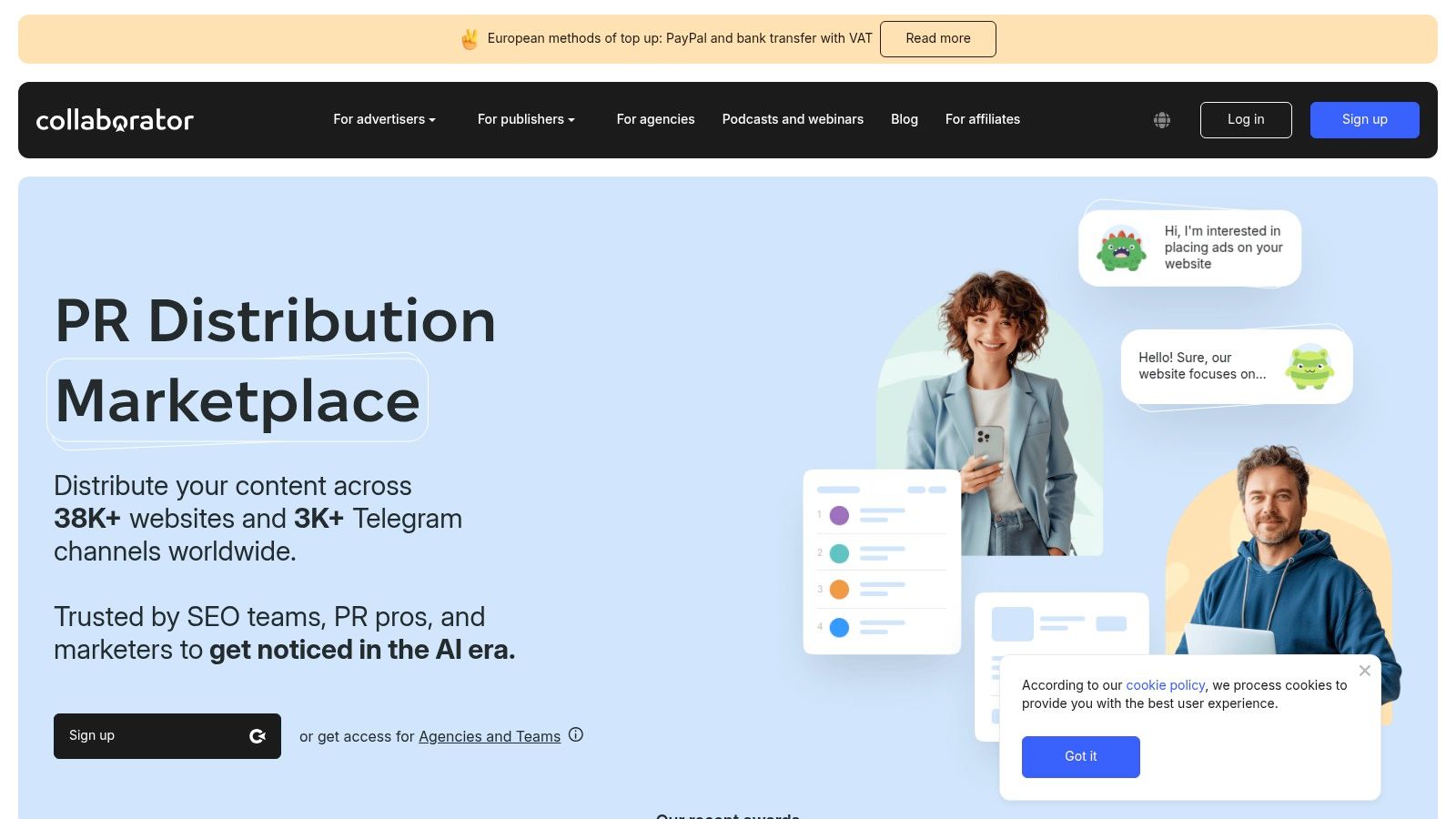
The platform’s strength lies in its transparency and simplicity. Users can browse an extensive catalog of websites, filtering them by niche, traffic metrics, and domain authority. This direct-deal approach removes the middleman, allowing for clear negotiation and efficient placement of content on relevant, authoritative sites. It streamlines the entire outreach, negotiation, and publishing workflow into one manageable interface.
Key Features and Pricing
Collaborator.pro’s features are centered on making the process of buying and selling content placements as smooth as possible. It empowers users to find the perfect outlet for their content without the guesswork of traditional outreach.
- Extensive Website Database: Access a large, curated catalog of websites ready to accept sponsored content and guest posts.
- Detailed Site Metrics: Each publisher listing includes key SEO metrics (like Ahrefs and SimilarWeb data) to help you make informed decisions.
- Direct Communication: A built-in messaging system facilitates direct negotiation with site owners.
- Secure Transaction System: Manages payments and holds funds in escrow until the content is published as agreed.
Pricing: Collaborator.pro is free to join for both advertisers and publishers. Advertisers pay per placement, with prices set by individual publishers. The platform charges a service fee on transactions, making it a flexible, pay-as-you-go model with no monthly subscription required.
| Pros | Cons |
|---|---|
| Simplifies the complex process of paid placements | Quality of publishers can vary, requiring careful vetting |
| Transparent pricing and direct negotiation | Primarily focused on one channel (guest posts/PR) |
| Affordable entry point for small businesses | Lacks the broader automation features of all-in-one suites |
Ideal Use Case: Collaborator.pro is best suited for SEO specialists, content marketers, and marketing agencies focused on link building and off-page SEO. It’s perfect for those who need to scale their guest posting efforts efficiently without committing to a high-cost monthly subscription.
12. StructuredWeb
StructuredWeb addresses a very specific and complex challenge: distributing content through a network of channel partners. It’s a dedicated channel marketing automation platform designed for large enterprises that sell through resellers, distributors, or franchisees. Unlike typical social media schedulers, this tool acts as a centralized content hub, empowering partners to co-brand and deploy corporate marketing materials within their local markets, making it a powerful piece of content distribution software for indirect sales models.
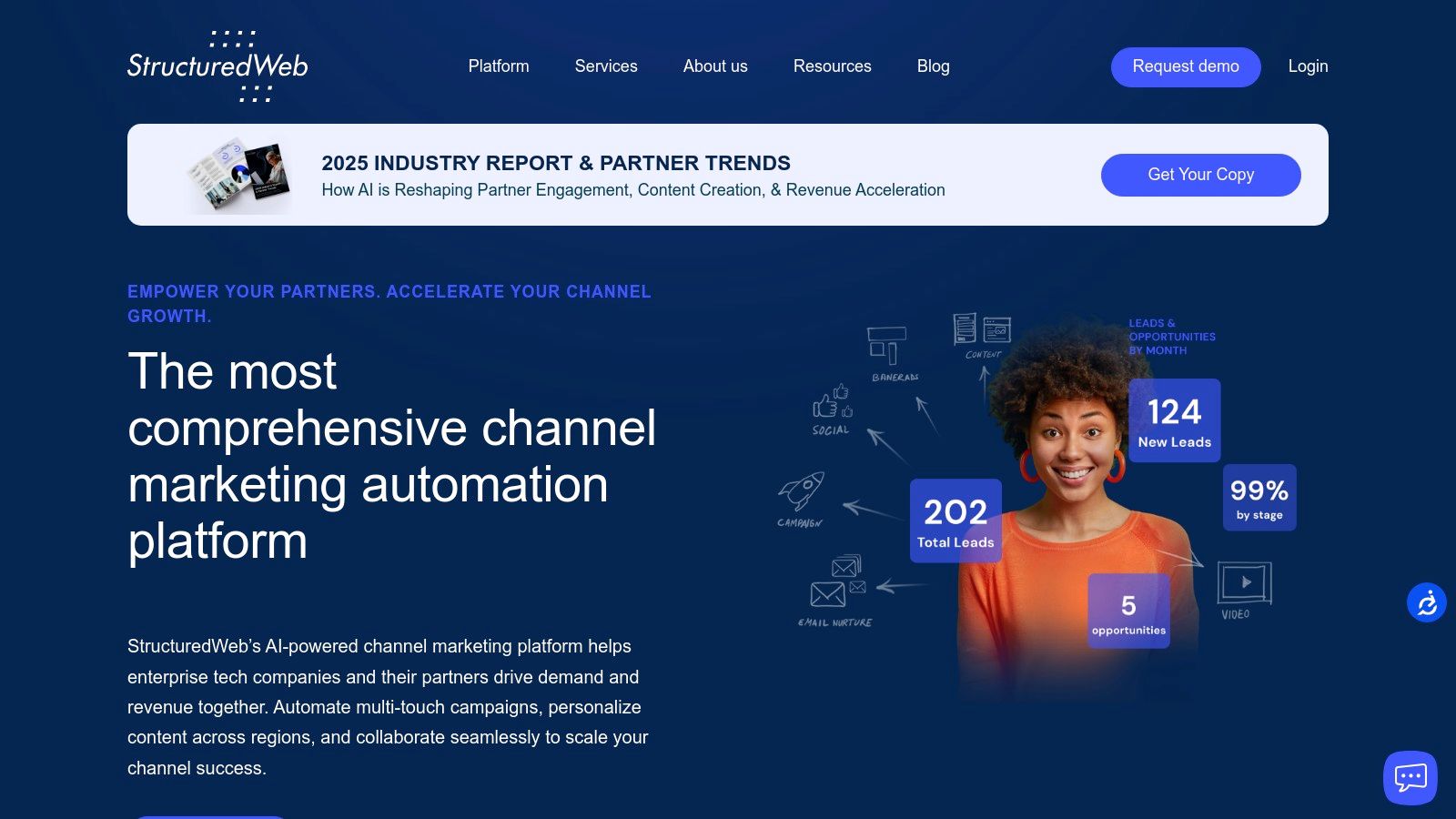
The platform’s core strength is enabling brand consistency and scale across a decentralized network. A corporate marketing team can create a campaign, load it into StructuredWeb, and allow hundreds or thousands of partners to easily execute it via email, social media, or syndicated web content. This solves the common problem of partners creating off-brand materials or failing to market at all, bridging the gap between corporate strategy and local execution.
Key Features and Pricing
StructuredWeb is built to manage the entire partner marketing lifecycle, from content provision to performance tracking. Its features focus on making it simple for partners to participate while giving the central brand full control and visibility.
- Channel Marketing Automation: Provides partners with pre-built, co-brandable campaigns they can launch with a few clicks.
- Content Syndication: Automatically pushes updated content (like blog posts or product pages) to partner websites.
- Partner Engagement Tools: Includes lead management and tools to help partners follow up on marketing-generated interest.
- Analytics and Reporting: Offers comprehensive dashboards to track partner adoption and campaign performance across the entire channel.
Pricing: StructuredWeb does not publicly list its pricing. Costs are customized based on the size of the partner network and required features, so you must contact their sales team for a quote.
| Pros | Cons |
|---|---|
| Enhances brand control across partner channels | Pricing is not transparent and requires direct contact |
| Streamlines content distribution at scale | Can have a steep learning curve for new users |
| Empowers partners with ready-to-use materials | Niche focus, not suitable for direct-to-consumer use |
Ideal Use Case: StructuredWeb is best for global B2B enterprises in sectors like tech, manufacturing, or finance that rely heavily on a channel sales model. It is perfect for organizations needing to activate and manage the marketing efforts of a large, diverse partner ecosystem.
Content Distribution Software Overview
| Platform | Core Features/Capabilities | User Experience & Quality ★ | Value Proposition 💰 | Target Audience 👥 | Unique Selling Points ✨ |
|---|---|---|---|---|---|
| 🏆 EvergreenFeed | Automates Buffer posting; custom content buckets | ★★★★★ Saves 7+ hrs/week; intuitive dashboard | Free signup; paid upgrades available | Social managers, SMBs, marketers | Smart scheduling by category; Buffer integration |
| HubSpot Marketing Hub | CRM, SEO, social management, email automation | ★★★★ User-friendly; extensive resources | Premium pricing; scalable solution | Businesses of all sizes | All-in-one marketing platform |
| Hootsuite | Multi-platform scheduling; social listening | ★★★★ Robust analytics; somewhat complex UI | Mid to high pricing tiers | Agencies, enterprises | Extensive app integrations |
| Buffer | Simple scheduling; engagement analytics | ★★★★ Intuitive; affordable for small biz | Affordable entry-level pricing | Small businesses, teams | Browser extension; collaboration tools |
| Mailchimp | Email campaigns; marketing automation | ★★★★ User-friendly templates and design | Free tier; pricing scales with list | Marketers, e-commerce | Strong email and automation tools |
| Bynder | Digital asset management; brand management | ★★★★ Efficient workflows; scalable | Custom pricing; contact required | Enterprises, brands | Brand consistency; version control |
| SocialPilot | Bulk scheduling; client management | ★★★★ User-friendly; supportive customer care | Affordable plans for agencies | Agencies, professionals | Content curation; multi-account mgmt |
| Paperflite | Content management; engagement analytics | ★★★★ User-friendly; strong support | Higher pricing for SMBs | Sales, marketing teams | Personalized client content experience |
| Joomag | Digital publications; multi-channel distribution | ★★★★ Versatile tools; requires training | Premium pricing | Content creators, enterprises | Interactive digital content editor |
| Gain | Scheduling + client collaboration | ★★★★ Simple workflows; affordable for agencies | Mid-priced plans | Agencies, social media teams | Approval workflows; client collaboration |
| Collaborator.pro | PR distribution; SEO tools | ★★★ User-friendly; affordable | Low cost for SMBs | Advertisers, small businesses | Large website database; campaign support |
| StructuredWeb | Channel marketing automation; partner tools | ★★★ More complex; scalable for enterprises | Custom pricing; enterprise focus | Large enterprises | Partner engagement; global scale |
Final Thoughts
Navigating the expansive landscape of content distribution software can feel overwhelming, but making an informed choice is the critical final step in ensuring your content actually reaches and resonates with your target audience. We’ve explored a diverse range of platforms, from all-in-one marketing powerhouses like HubSpot to specialized social media schedulers like Buffer and SocialPilot, and even unique solutions for sales enablement like Paperflite. The key takeaway is that there is no single “best” tool; the right choice is entirely dependent on your specific goals, team size, content types, and budget.
The journey from content creation to audience engagement is paved with strategic distribution. Simply hitting “publish” is no longer enough. The tools we’ve detailed are designed to bridge that gap, transforming your high-quality content from a static asset into a dynamic driver of traffic, leads, and brand authority.
How to Choose the Right Content Distribution Software for You
Selecting the ideal platform requires a thoughtful assessment of your unique operational needs. Before committing to a subscription, your team should conduct a thorough internal audit. Consider the following crucial questions to guide your decision-making process:
- What are your primary distribution channels? Are you heavily focused on social media, or is your strategy a mix of email, partner networks, and sales outreach? A tool like Hootsuite excels at social, while a platform like StructuredWeb is built for partner channel marketing.
- What is the scale of your operation? A solopreneur or small business might find the simplicity and affordability of Buffer or SocialPilot perfectly adequate. In contrast, a larger enterprise with complex workflows and multiple teams will benefit from the robust approval systems and analytics found in platforms like HubSpot or Gain.
- What types of content do you produce? If your output is primarily interactive digital publications like magazines or catalogs, a specialized tool like Joomag is purpose-built for your needs. If you manage a vast library of brand assets for various teams, a Digital Asset Management (DAM) system like Bynder is essential.
- What is your budget? Be realistic about what you can afford, not just for the monthly subscription but also for any implementation or training costs. Many tools offer tiered pricing, allowing you to start small and scale up as your needs and revenue grow.
- How important are analytics and reporting? If data-driven decision-making is central to your strategy, prioritize tools with advanced analytics. HubSpot Marketing Hub, for example, offers deep insights into how your distribution efforts tie directly to lead generation and customer acquisition.
Key Implementation Considerations
Once you’ve made your selection, successful implementation is paramount. Don’t just hand the tool to your team and expect magic to happen.
- Develop a Clear Workflow: Document exactly how the new software will fit into your existing content creation and approval processes. Who is responsible for scheduling? Who approves the posts?
- Invest in Training: Ensure every team member who will use the platform is properly trained. Utilize the provider’s knowledge base, tutorials, and customer support to get everyone up to speed.
- Integrate with Your Existing Stack: The true power of modern content distribution software is unlocked through integration. Connect it with your project management tools, your CRM, and your analytics platforms to create a seamless marketing ecosystem.
- Start Small and Iterate: Don’t try to launch on every channel with every feature all at once. Begin with your most important channel, master the workflow, analyze the results, and then gradually expand your efforts.
Ultimately, the right content distribution software acts as a force multiplier for your content strategy. It saves you invaluable time through automation, provides the data needed to refine your approach, and ensures your message consistently reaches the right people on the right platforms. By carefully evaluating your needs against the solutions available, you can select a partner that will not only streamline your workflow but also amplify your brand’s voice in a crowded digital world.
Ready to put your content on autopilot and ensure it gets the long-term visibility it deserves? EvergreenFeed specializes in just that, automatically recycling your best blog posts on social media. It’s the perfect, focused content distribution software to maximize the lifespan and impact of every article you publish. Discover how you can set it, forget it, and watch your traffic grow at EvergreenFeed.




